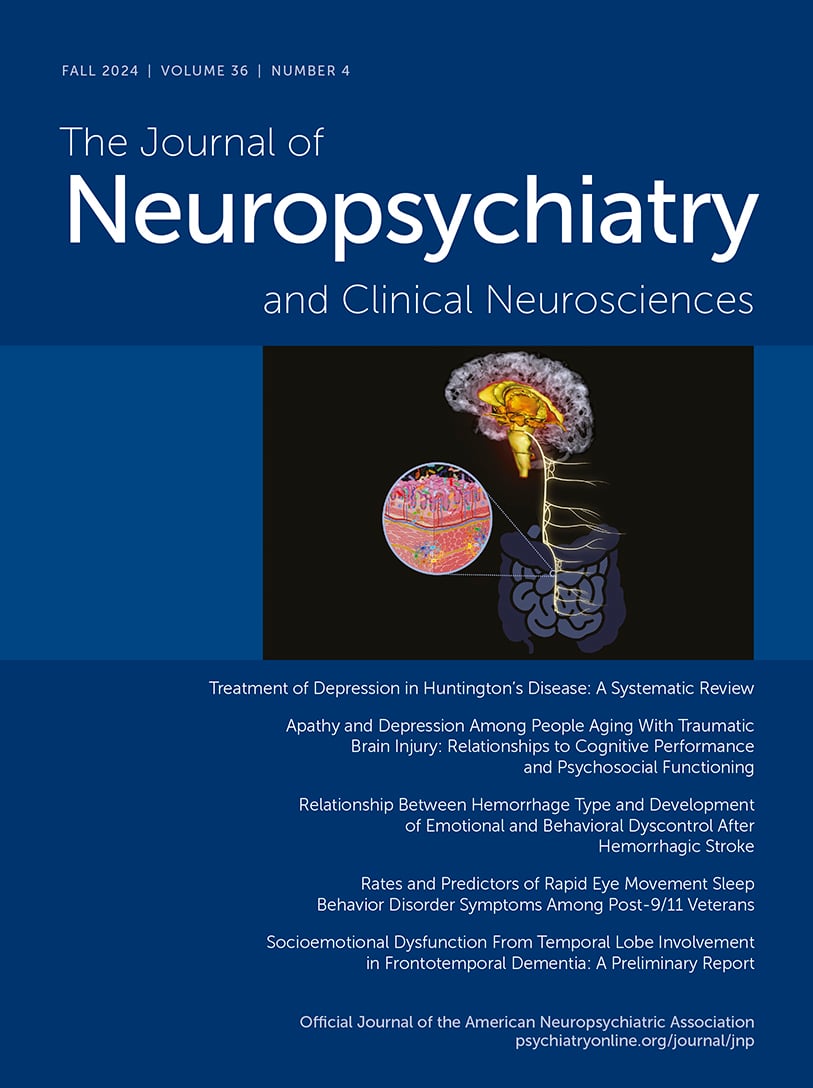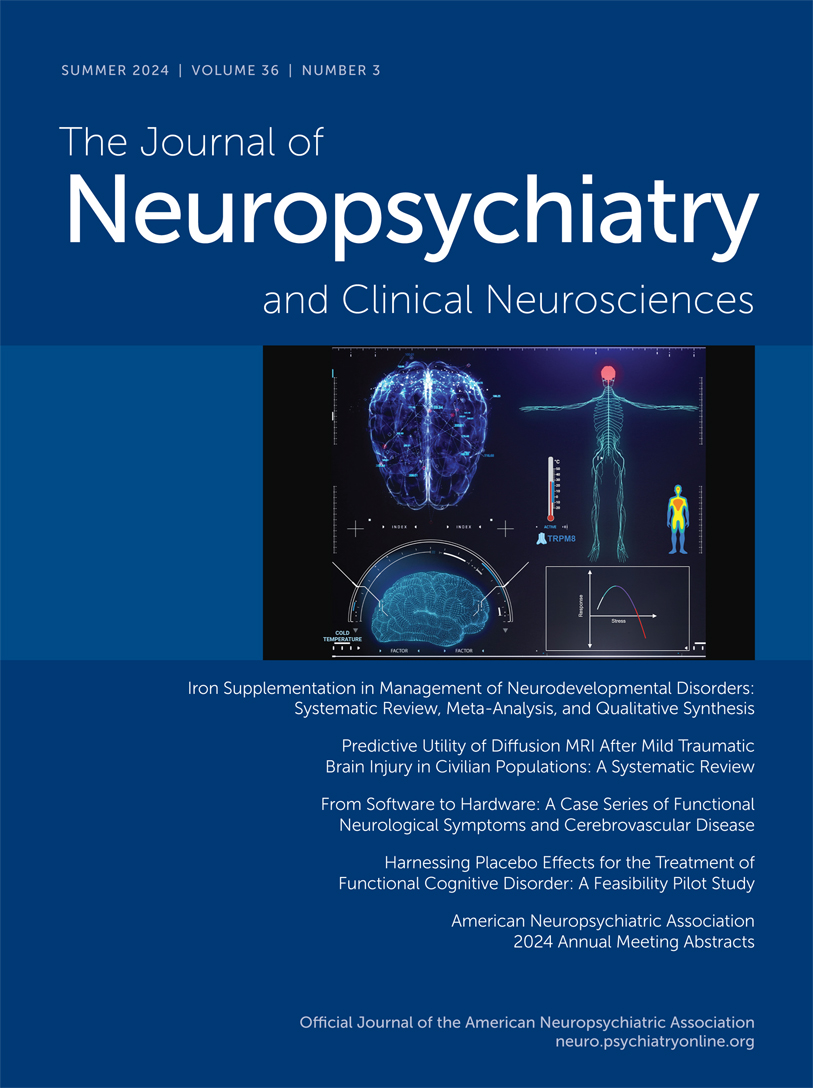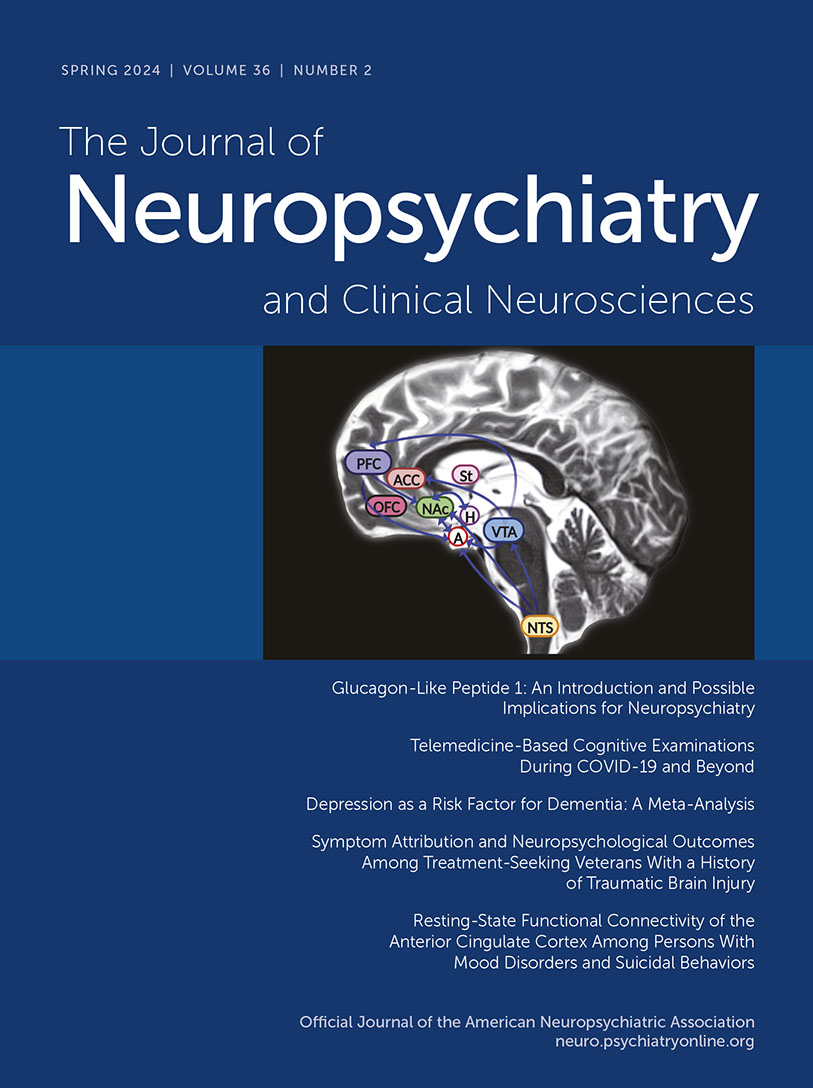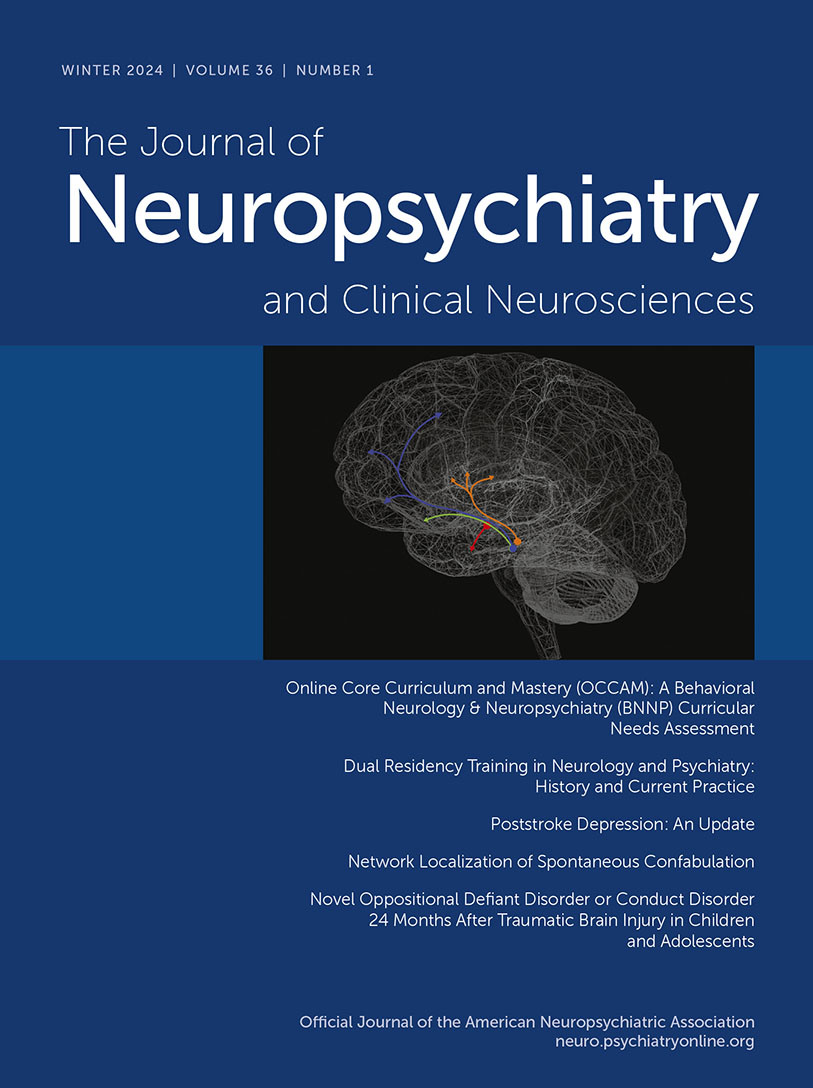The Journal of Neuropsychiatry and Clinical Neurosciences
- Volume 17
- Number 1
- February 2005
Windows to the Brain
Special Article
Publication date: 01 February 2005
Pages7–19This review presents data showing that apathy is common across a number of disorders. Apathy is not only common, but is also associated with significant problems: reduced functional level, decreased response to treatment, poor illness outcome, caregiver ...
https://doi.org/10.1176/jnp.17.1.7Publication date: 01 February 2005
Pages20–28Mood disorders in patients with epilepsy are not frequently diagnosed and not treated. Because of the high prevalence of depression and the resulting high suicide rate, precise diagnosis and effective therapy are very important. Frequently, the clinical ...
https://doi.org/10.1176/jnp.17.1.20Regular Article
Publication date: 01 February 2005
Pages29–35Aggression is a common and costly problem in youth with developmental disabilities. Rating scales that accurately capture and measure subtypes of aggression phenomenology, frequency and severity are urgently needed, in both clinical practice and research. ...
https://doi.org/10.1176/jnp.17.1.29Publication date: 01 February 2005
Pages36–44Violent behavior is a significant problem in the psychiatric hospital setting. Persistently violent patients often require seclusion and/or restraints and typically receive high doses of medication and polypharmacy. Clozapine has been found to be ...
https://doi.org/10.1176/jnp.17.1.36Publication date: 01 February 2005
Pages45–50Cataplexy is an intriguing example of how emotions can trigger muscle weakness by activating neural pathways. When associated with excessive daytime sleepiness, cataplexy is considered pathognomonic of narcolepsy. A questionnaire was administered to 55 ...
https://doi.org/10.1176/jnp.17.1.45Publication date: 01 February 2005
Pages51–60The authors’ main objective was to investigate the relationship between changes in psychopathological, cognitive and activity of daily living (ADL) instrument scores over 12 months in community-dwelling persons with Alzheimer’s disease (AD). A secondary ...
https://doi.org/10.1176/jnp.17.1.51Publication date: 01 February 2005
Pages61–65Traumatic brain injury (TBI) and major depression are neuropsychiatric conditions that have been associated with cognitive dysfunction. The aim of this study was to explore the relationship between major depression and cognitive impairment following mild ...
https://doi.org/10.1176/jnp.17.1.61Publication date: 01 February 2005
Pages66–74Patients with damage to the frontal lobes frequently exhibit impaired social behavior, but it is not clear which specific processes are disrupted. The authors investigated the ability to interpret nonverbal emotional expression in patients with lesions ...
https://doi.org/10.1176/jnp.17.1.66Publication date: 01 February 2005
Pages75–83Several recent studies using functional magnetic resonance imaging (fMRI) during recognition memory tests have suggested that the ability to neuromodulate as a function of cognitive demand may be impaired in older adults due to age-related cell loss and ...
https://doi.org/10.1176/jnp.17.1.75Publication date: 01 February 2005
Pages84–90Visual inspection of the unquantified electroencephalogram (EEG) remains the sole technique to confidently detect epileptiform discharges. Usefulness of this procedure in psychiatric research is hampered by reported prevalence of abnormalities in normal ...
https://doi.org/10.1176/jnp.17.1.84Publication date: 01 February 2005
Pages91–97Smith-Magenis Syndrome (SMS) is a complex, pediatric, neurobehavioral, contiguous gene syndrome ascribed to interstitial microdeletion of chromosome 17, band 11.2. The syndrome is characterized by distinctive behavioral, neurocognitive, and ...
https://doi.org/10.1176/jnp.17.1.91Publication date: 01 February 2005
Pages98–105The Computer-Administered Neuropsychological Screen for Mild Cognitive Impairment (CANS-MCI), a computer administered, scored, and interpreted touch screen battery was evaluated for its ability to detect mild cognitive impairment. Subjects were three ...
https://doi.org/10.1176/jnp.17.1.98Publication date: 01 February 2005
Pages106–113Substantial research has demonstrated that adults with schizophrenia display intellectual decline compared to their premorbid levels of functioning. Research of this type, however, is not as common in adolescents with psychotic disorders. Since many first-...
https://doi.org/10.1176/jnp.17.1.106Clinical and Research Reports
Publication date: 01 February 2005
Pages114–118Apathy is a prominent neuropsychiatric symptom associated with human immunodeficiency virus (HIV). The increased frequency of apathy in this population may reflect the direct involvement of the virus on the central nervous system (CNS), but the severity ...
https://doi.org/10.1176/jnp.17.1.114Publication date: 01 February 2005
Pages119–121Patients with Huntington’s disease show deficits in recognizing disgust in the facial expressions and vocal intonations of others. In this study, the authors demonstrate that these disgust-related deficits extend to foul-smelling olfactory stimuli and ...
https://doi.org/10.1176/jnp.17.1.119Letter
Calendar
Past Issues
View Issues Archive
Vol. 36 | No. 4

Vol. 36 | No. 3

Vol. 36 | No. 2
